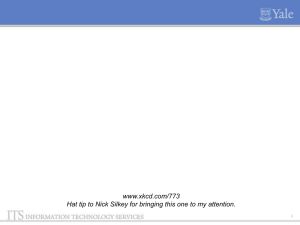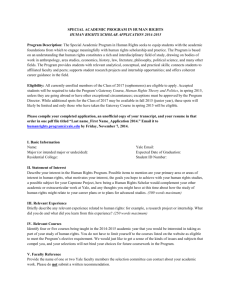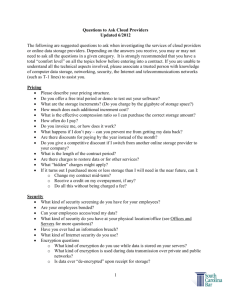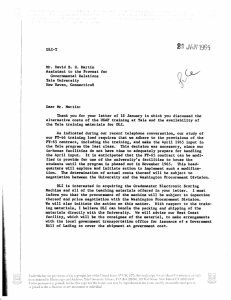GersteinLab-Resources
advertisement
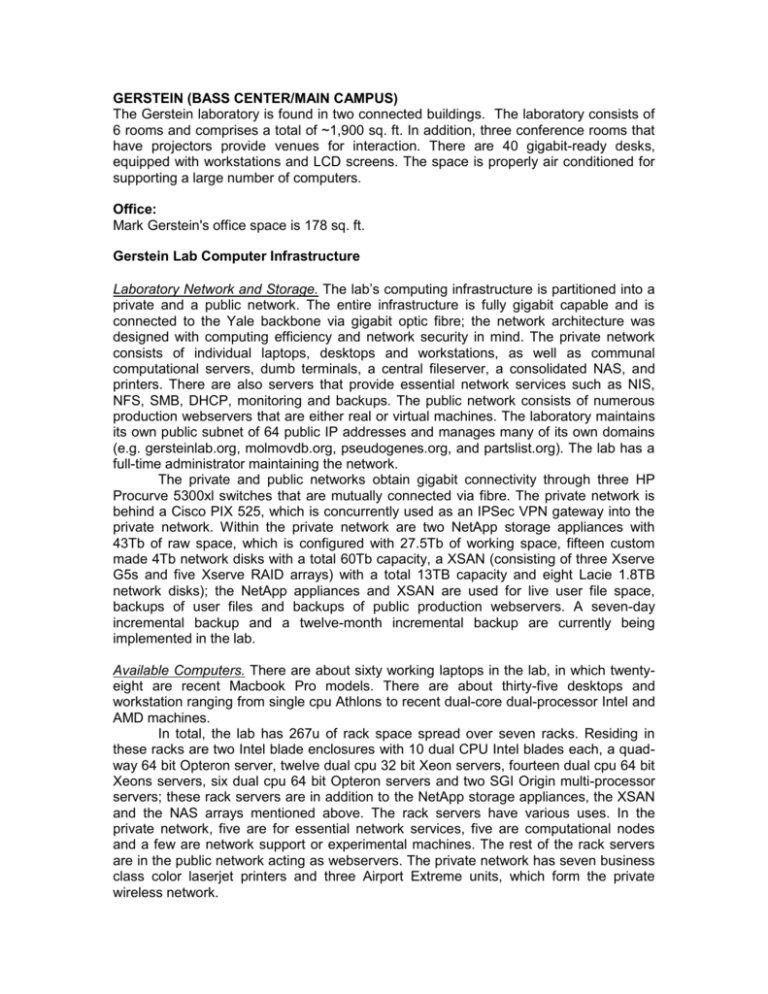
GERSTEIN (BASS CENTER/MAIN CAMPUS) The Gerstein laboratory is found in two connected buildings. The laboratory consists of 6 rooms and comprises a total of ~1,900 sq. ft. In addition, three conference rooms that have projectors provide venues for interaction. There are 40 gigabit-ready desks, equipped with workstations and LCD screens. The space is properly air conditioned for supporting a large number of computers. Office: Mark Gerstein's office space is 178 sq. ft. Gerstein Lab Computer Infrastructure Laboratory Network and Storage. The lab’s computing infrastructure is partitioned into a private and a public network. The entire infrastructure is fully gigabit capable and is connected to the Yale backbone via gigabit optic fibre; the network architecture was designed with computing efficiency and network security in mind. The private network consists of individual laptops, desktops and workstations, as well as communal computational servers, dumb terminals, a central fileserver, a consolidated NAS, and printers. There are also servers that provide essential network services such as NIS, NFS, SMB, DHCP, monitoring and backups. The public network consists of numerous production webservers that are either real or virtual machines. The laboratory maintains its own public subnet of 64 public IP addresses and manages many of its own domains (e.g. gersteinlab.org, molmovdb.org, pseudogenes.org, and partslist.org). The lab has a full-time administrator maintaining the network. The private and public networks obtain gigabit connectivity through three HP Procurve 5300xl switches that are mutually connected via fibre. The private network is behind a Cisco PIX 525, which is concurrently used as an IPSec VPN gateway into the private network. Within the private network are two NetApp storage appliances with 43Tb of raw space, which is configured with 27.5Tb of working space, fifteen custom made 4Tb network disks with a total 60Tb capacity, a XSAN (consisting of three Xserve G5s and five Xserve RAID arrays) with a total 13TB capacity and eight Lacie 1.8TB network disks); the NetApp appliances and XSAN are used for live user file space, backups of user files and backups of public production webservers. A seven-day incremental backup and a twelve-month incremental backup are currently being implemented in the lab. Available Computers. There are about sixty working laptops in the lab, in which twentyeight are recent Macbook Pro models. There are about thirty-five desktops and workstation ranging from single cpu Athlons to recent dual-core dual-processor Intel and AMD machines. In total, the lab has 267u of rack space spread over seven racks. Residing in these racks are two Intel blade enclosures with 10 dual CPU Intel blades each, a quadway 64 bit Opteron server, twelve dual cpu 32 bit Xeon servers, fourteen dual cpu 64 bit Xeons servers, six dual cpu 64 bit Opteron servers and two SGI Origin multi-processor servers; these rack servers are in addition to the NetApp storage appliances, the XSAN and the NAS arrays mentioned above. The rack servers have various uses. In the private network, five are for essential network services, five are computational nodes and a few are network support or experimental machines. The rest of the rack servers are in the public network acting as webservers. The private network has seven business class color laserjet printers and three Airport Extreme units, which form the private wireless network. Software. A number of open source software, programs created in-house, and proprietary software is used by the lab researchers for their needs. The lab maintains a set of wiki servers for the documentation of internal information and the public dissemination of information. The lab also manages mailman servers for its mailing lists. The compute nodes are mainly used to develop and run Java and Perl code and to perform Matlab and Gromacs calculations. The public webservers are used to deploy Java, Perl, PHP Individual tasks are coordinated by a web group calendar and a Request Tracker (RT) system. Yale Life Sciences Supercomputer. The Gerstein laboratory has priority access to two of the Yale supercomputers, namely BulldogI and BulldogC, and regular access to six other Yale supercomputers. There are two full-time administrators maintaining the supercomputer. BulldogI is a cluster consisting of a head node and 170 Dell PowerEdge 1955 nodes, each containing 2 dual core 3.0 Ghz Xeon 64 bit EM64T Intel cpus, for a total of 680 cores. Each node has 16 GB RAM. The network is Gigabit ethernet. Bulldogi runs a high performance Lustre filesystem. It is managed via PBS. Three 20Tb Dell Power Vault with storage arrays are attached to BulldogI and are dedicated for Gerstein laboratory use. BulldogC is a cluster consisting of a head node and 130 compute nodes, each containing two 3.2 Ghz EM64T Xeons. All nodes run Redhat Enterprise R3 and each node has 8 GB of RAM and a small local disk. There is a large SAN disk array that serves a number of filesystems, including home directories, to every compute node. Jobs are run using a batch queueing system (PBS). A number of useful packages are installed, including LAM mpi, mpich, R, java, Intel and PGI compilers. BulldogC was purchased with funding from an NIH High End Shared Instrumentation Grant Application. The laboratory also has priority access to a SGI F1240 system. This system has 12 Xeon E5345 Quad-Core 2.33GHz CPUs (for a total of 48 processor cores), with 2 x 4M L2 cache per CPU, a 1333MHz front side bus, 96GB of memory, and 6 Raptor 150GB, 10K rpm SATA drives. It runs SUSE Linux Enterprise Server 10 as a system single image. That is, all 48 cores are managed by a single process scheduler, and the 96 GB memory is, in principle, addressable by a single process. In practice, system caches and buffers reduce the maximum amount of memory available to any given process to about 70 GB. In many ways then, the system can be thought of as an SMP, but in terms of hardware architecture it is closer to an infiniband-connected cluster. Core Lab. The Gerstein Lab network is sister to the Yale Center for Structural Biology (CSB) Core laboratory network and they are physically network neighbors. The Core laboratory supports the work of all the people associated with the CSB, in total about 200 users and >200 computers. These include a number of high-performance graphics workstations for visualizing macromolecular structures and complex data sets. The CSB Core staff of 3 FTE provides support to the associated CSB laboratories as well as the Core computers. Oracle Server. Yale University has an institutional site license for the Oracle database management system. As a result, many major administrative computing systems at Yale are being developed using Oracle, and Yale’s ITS staff has extensive Oracle experience. Yale ITS maintains and operates several Oracle database systems at the School of Medicine, and provides access to these machines to many different projects. There are several advantages to using institutional servers. The ITS staff backs up each database on a regular schedule, typically with full backups weekly and partial backups several times a day. The ITS staff maintains the hardware of the database machine, the system software, and the Oracle software. They perform periodic upgrades when new versions of the software become available. They also handle any systems problems that occur, and are available to help troubleshoot any application problems that arise.
